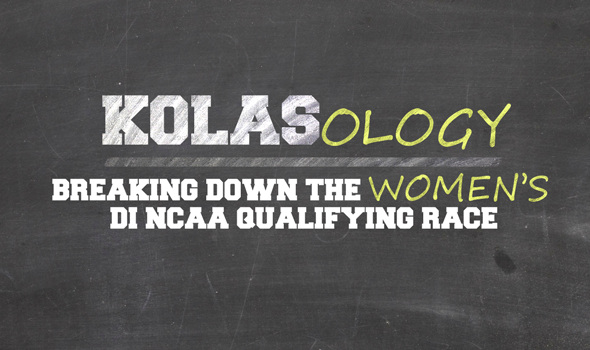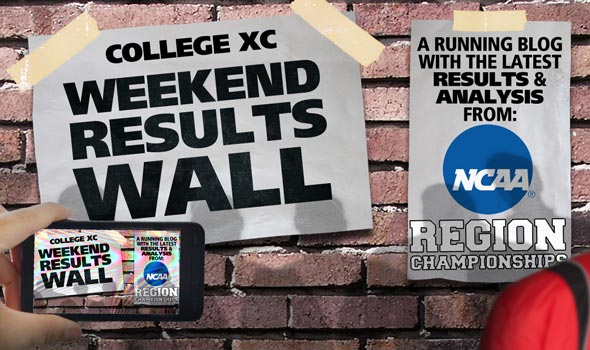
USTFCCCA News & Notes

Division I Women’s Qualifying Scenarios: So Much Depends Upon…
NEW ORLEANS – In the breakdown of the men’s NCAA Championships qualifying picture, we explained that in order to understand who’s going to qualify for nationals, you have to understand that it’s all connected.
|
William Carlos Williams, the original Run Junkie, was only a part-time poet and running connoisseur. For his full-time job, he was a doctor, meaning that he had more than a passing knowledge of math. And that means that WCW would have appreciated the complexity of the Division I qualifying process, where any one variable moving in one region could change the calculus for every team in the country.
Below is a full breakdown of all of the factors in play in the nine regional meets. As with the men’s piece, the assumptions stem from a full rundown of the 31 teams who would advance if the regional rankings held to form, plus the next 18 who would be considered for qualifying,. Yellow wins in the table are over teams that would give points if the chalk places stood up; red wins are over teams that could potentially give points if things start to get chaotic.
Your third grade math teacher demanded that you show your work, and you should equally sternly demand the same from your track bloggers. Here’s that table.
LetsRun ran a computer program over the rankings; this worthwhile post is basically a less sexy version of the table.
Flotrack did the same, but used their own regional rankings. You should check that out too.
For a step back from the big picture and an overview of each of the regions this weekend, check out our men’s overview and our women’s overview.
Friday’s going to be a fun and occasionally headache-inducing day. Follow along with us live! We’ll try to spare the headaches.
The Locks
17 of the 18 of the projected auto qualifiers are either chock full of points or are more than prohibitive favorites to finish in the top two on Friday. Those 17 teams fall into two slightly different but functionally indistinguishable groups. The first could ostensibly finish outside of AQ territory, but have been such Kolas gluttons that they’ll qualify anyway. Wisconsin, West Virginia, Minnesota, Colorado, New Mexico, Syracuse, Vanderbilt, Baylor, North Carolina, Virginia, and Stanford are in that group. The second crew consists of a combination of the very best teams in the nation, and the very best geographically located teams. Those top-two cinches are Michigan State, Georgetown, Iowa State, Florida State, Arkansas, and Oregon.
Additionally, the top three projected at-large teams have such rock-solid results that scenarios in which they don’t qualify are less likely than a black hole constructed by love saving the human race through a sixth-grader’s bedroom1. That trio consists of Michigan, Ohio State, and NC State.
One hates to make such categorical statements, especially regarding women’s college distance running. (But then I contradict myself.) If one were to take an anonymous poll of the assistant coaches of those 20 teams, though, the majority would admit to having already booked a block of hotel rooms in Terre Haute.
As mentioned above, 17 of the 18 teams ranked first or second in their respective regions are stone-cold locks to make nationals. The 18th is in a position that the Poet Laureate of TFRRS would savor.
so much depends
upon
…Iona2. If the Gaels automatically qualify out of the Northeast Region, then eight of the thirteen projected at-large teams pick up a point. If they don’t, things change drastically across the nation. Out of the eight teams that scooped that point off of Iona in Madison, five of them are well-situated with or without that win. Ohio State, Washington, Arizona State, Boise State, and Boston College all have two or more points even if they lose the Iona one. For UCLA, Toledo, and Dartmouth, though, fully half of their points were provided by Iona.
If Kate Avery ran and finished just 34th or better at adidas KolasFest 2k14©, Iona would have finished 9th and beaten every single one of those teams. So, the likeliest scenario is that Ricardo Santos’s top-ranked women3 do automatically qualify. But it’s certainly not implausible to have them outside of the top two—Flotrack has them finishing third in the region and thus missing NCAAs entirely.
Let’s break down who is hurt and helped in a few possible permutations of the Northeast. The pairs listed below are would-be auto qualifying teams. Note that the order of the two auto teams doesn’t matter.
Syracuse/Iona: the likeliest outcome. The teams listed above breathe easier, along with BYU and Notre Dame, who get a point off of Toledo qualifying.
Syracuse/Dartmouth: UCLA is hurt, and Iona could be fatally wounded and miss nationals entirely. Iona missing the meet could benefit Princeton—the only bubble team with two projected points. More later on the teams sitting outside of the bubble.
Iona/Dartmouth: This could drastically shake up the bottom of the meet. Boston College would lost a point, which then could potentially cause Virginia Tech to lose all of its points. VaTech’s two wins are off of BC and Syracuse. The teams that are hurt here are obviously the three ACC schools (‘Cuse, BC, VT) plus any team (cough-William & Mary-cough) hoping to beat Virginia Tech and get pushed in. The beneficiaries would be Princeton, again, and one-win Providence.
No matter how it plays out, so much resting on one team resting one runner at one meet is probably a good case against the labyrinthine and mostly loved current qualifying rules. Again: if Kate Avery ran at Wisconsin and basically tempo-ed one of the slowest 6ks of her college career, at least ten teams are in wildly different straits for making it to the national championship. That doesn’t seem right.
It was totally Ricardo Santos’s prerogative to sit out Kate Avery from the Commonwealth Games to conferences. In fact, if he brought her back too early and she was ragged in November or March or June, he’d semi-justifiably be getting raked across the internet coals. So, the answer definitely isn’t somehow forcing coaches to make the regular season count more4. And the answer isn’t using a committee to select the 31 teams. While the committee works for Division III because of the unfeasibility of massive regular-season inter-regional travel there, DI coaches and athletes deserve and prefer a measure of objectivity. Maybe the answer is simply that occasionally the current process provides unseemliness, but like Churchill said about democracy, it’s the worst system—except for all the others that have been tried.
What about the teams trying to get in?
Out of the 18 teams that would be left on the board if the 31 favorites made it, only two have any wins—Princeton and Providence. Let’s examine their paths to Terre Haute before covering the case for the other 16, who need to either make it automatically or get pushed in.
Though Providence only has a single point—they beat BYU at Wisconsin—they have the most realistic chance of beating a team or teams ranked ahead of them. The defending national champs were only 24 points behind BC and 54 (a slim margin at such an enormous regular-season meet) back of Dartmouth there. If the Friars beat both of those teams for third place, they’re in. If they beat one and get fourth, the Catholic school in Rhode Island5 better pray that whoever gets fourth ends up with enough points to push them in.
There’s one very simple, but unlikely, path for Providence: if William & Mary automatically qualifies out of the Southeast, Ray Treacy’s squad gets in before BYU does.
Princeton doesn’t have nearly as good of a chance of beating either of the projected AQ teams in the Mid-Atlantic—Georgetown and West Virginia are both podium contenders—but the Tigers’ second point could keep their season alive. If Iona and Dartmouth are the two auto teams out the Northeast, or if Toledo or BYU finish behind two winless teams, Princeton has a thin, tiebreaker-dependent shot.
The teams with the simplest but toughest routes to nationals are those looking to get pushed in or pull an auto-qualifying upset. If William & Mary finishes in the top four and the ACC school—any one of North Carolina, Virginia, NC State, or Virginia Tech would work—they beat finishes directly behind them in fifth, the Tribe will get pushed in.
Boise State and Arizona State have so many wins that they’re likely to make it wherever they land at regionals, as long as they only lose to a total of one push team. In other words, if those two schools and Portland OR UC Davis (but not both!) finish 5-6-7 in the West, all three schools will make it. Of course, both BSU and ASU are ranked ahead of two-win UCLA, and the Bruins have a bit less push power.
As recently as the end of the regular season, Northern Arizona was ranked ahead of BYU in the Mountain. Per LetsRun, if the ‘Jacks beat the Cougars, BYU will push in NAU as long as form holds in the West. Northern Arizona making NCAAs would likely doom Notre Dame; it would mean that BYU was team #31 into nationals, depriving the Irish of one win.
If Alabama can somehow close the 55-point gap between it and Vanderbilt from their conference meet, they’re in. And Lamar has gotten minimal buzz as an upset candidate out of the South Central, but the Cardinals only finished 43 points behind Baylor at Pre-Nationals. As SMU showed us last year, in the South Central, anything is possible.
|
1. Sorry. (Back to story) 2. Not sure how we went an entire season with such a relevant Iona team without mentioning Jimmy V’s immortal line: “I’d tell people, ‘I’m Jim Valvano, Iona College.’ And they’d tell me, ‘Son, you’re too young to own a college.’" (Back to story) 3. Not “girls.” Not “ladies.” Please. (Back to story) 4. By the way, the myth of B teams degrading the regular season is laughably overblown. There were four instances of men’s teams running a B team at a major meet this fall, and just one instance of a women’s team doing so. At the five biggest meets of the year—Wisconsin, Pre-Nats, Roy Griak, Notre Dame, and conference championships, the Toledo women at Pre-Nats were the only team to run their B team. (Back to story) 5. Boston College, Providence, and Iona are all Catholic schools. (Back to story) |



